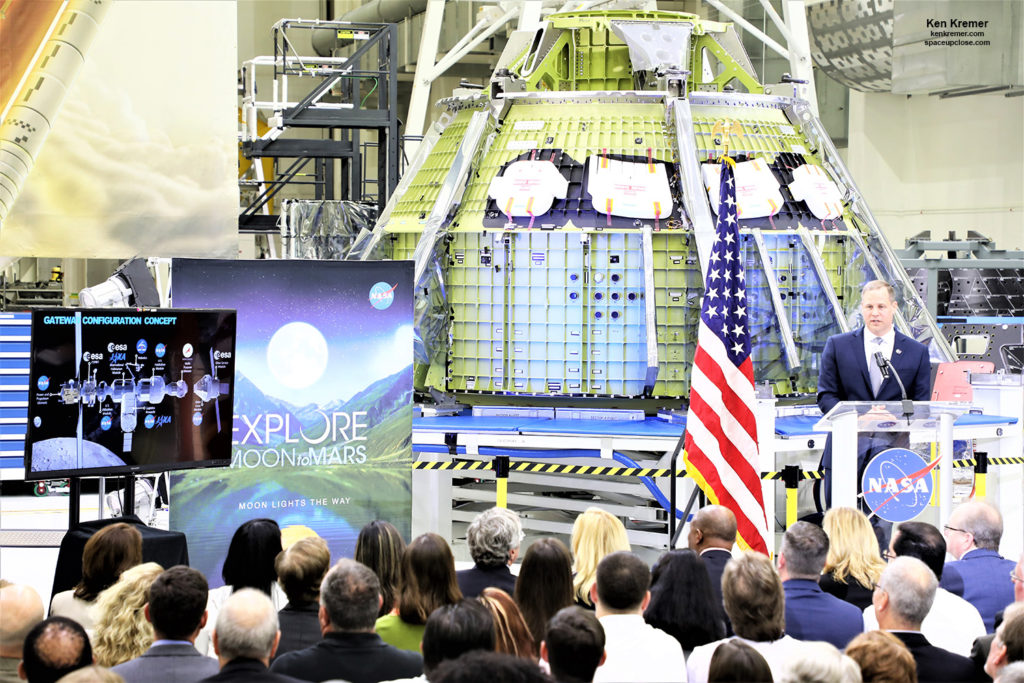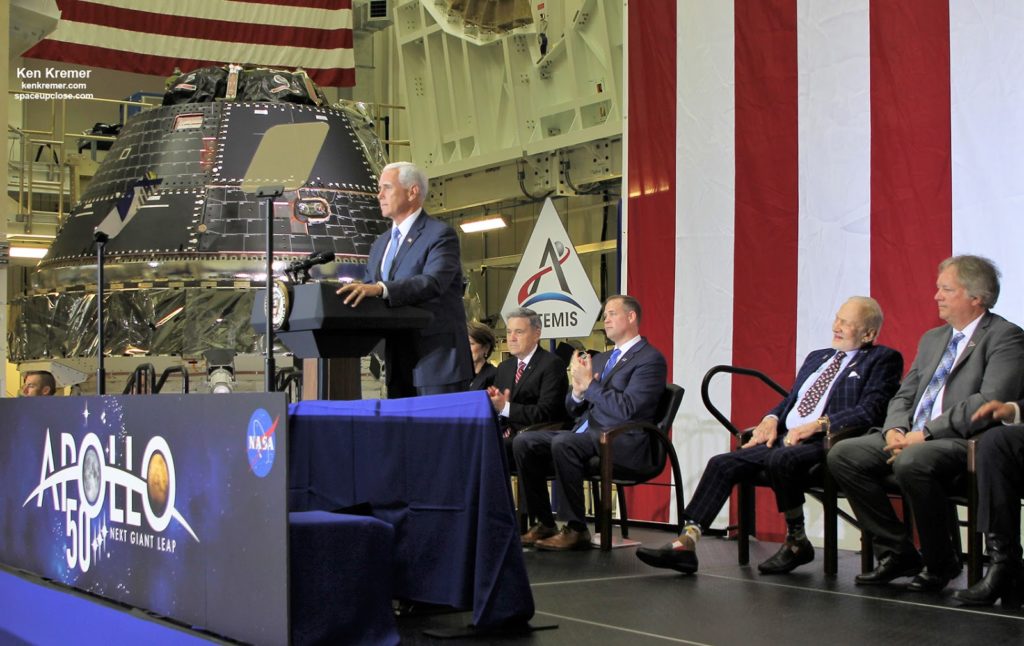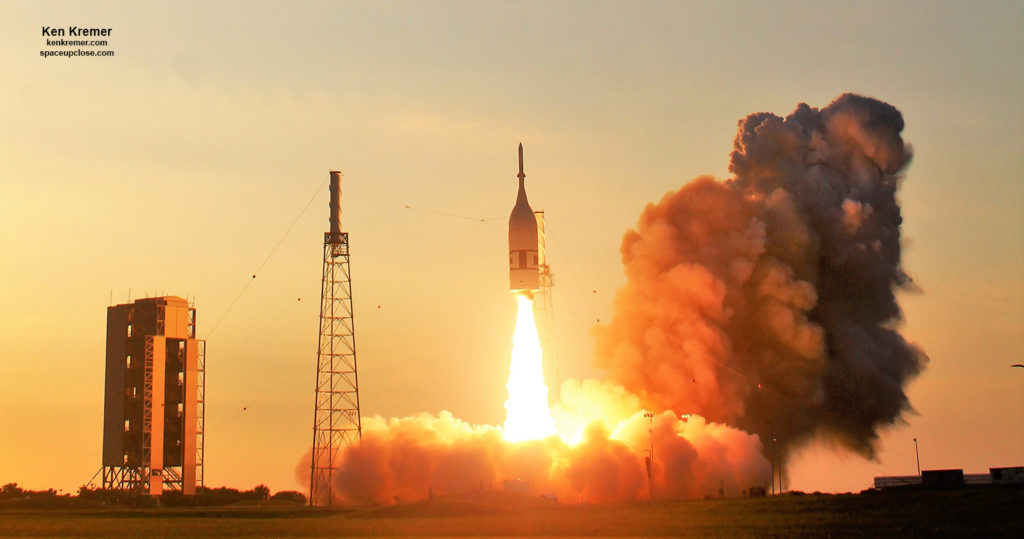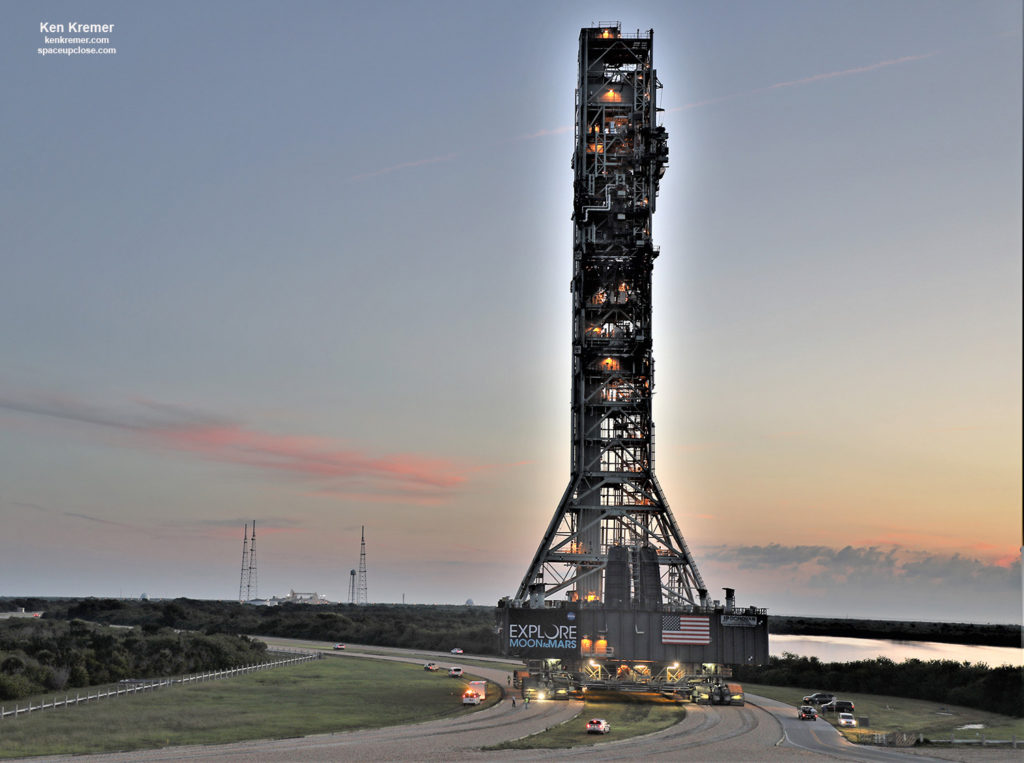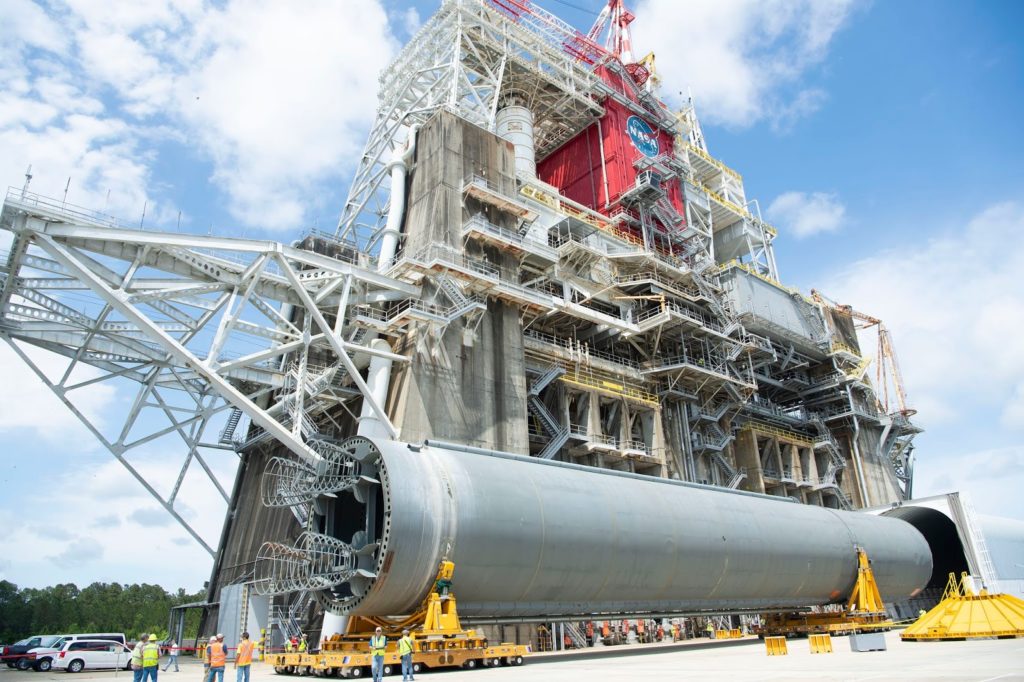 |
|
A pathfinder test article for NASA’s SLS core stage rests beside the B-2 test stand at the Stennis Space Center in Mississippi that will be used for the ’Green-Run’ static fire test. Credit: NASA
|
Ken Kremer — SpaceUpClose.com & RocketSTEM – 27 July 2019
KENNEDY SPACE CENTER, FL/MICHOUD ASSEMBLY FACILITY,LA – After months of
deliberating back and forth NASA Administrator Jim Bridenstine announced July 25 that he has ‘greenlighted’ the “Green Run” full duration engine test of the agency’s core stage for the mammoth Space Launch System (SLS) moon rocket next year at NASA’s Stennis Space Center – ahead of the upcoming Artemis 1 lunar mission launch.
Bridenstine had considered curtailing and even cancelling the 8 minute long full duration core stage engine test until recently in favor of a much shorter duration static test fire lasting only a few seconds on the launch pad at the Kennedy Space Center – but ultimately cited astronaut safety and rocket reliability as the top reasons for his decision to give the ‘Go Ahead’ to the ‘Green Run’
The decision to conduct the ‘Green Run’ test was announced by Bridenstine by tweet and by NASA in a statement on July 25.
“@NASA will do a Green Run test for @NASA_SLS prior to #Artemis1. Here’s why: -Astronaut
safety is our #1 priority -Increases probability of a successful Moon Landing in 2024 -Its important to discover issues earlier rather than later”
The ”Green Run” test involves conducting a full duration eight minute long static fire test of the 212 foot long (64.6 m) SLS core stage at the B-2 Test Stand at NASA’s Stennis Space Flight enter near Bay St. Louis, Mississippi.
By therein lies the crux of the matter. The “green run” test campaign could take as long as six months and would make it very difficult to achieve the Artemis-1 launch by the end of 2020- before the end of Presidents Trump’s current term in office.
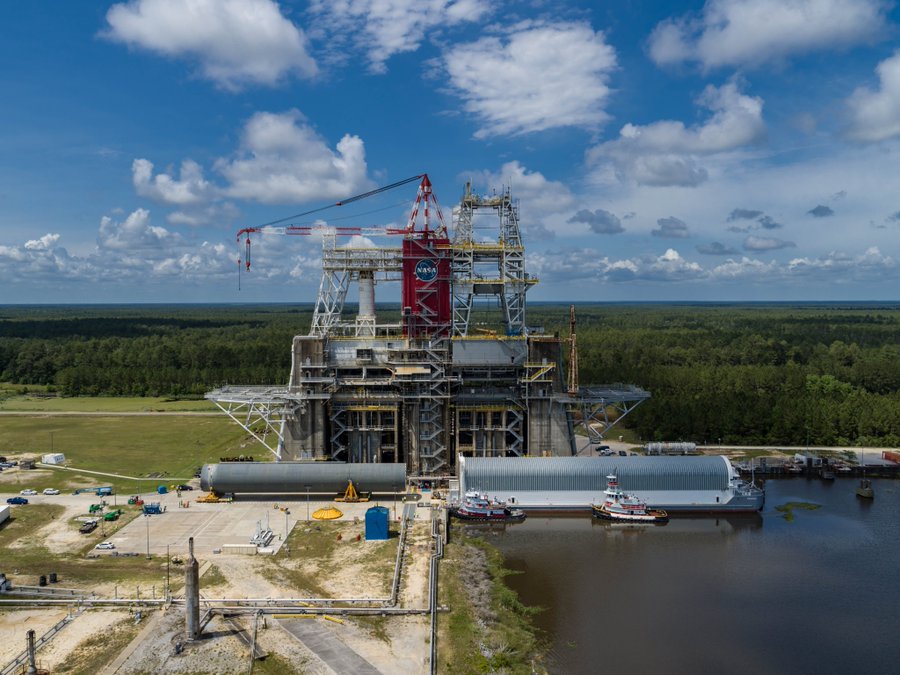 |
|
A pathfinder test article for NASA’s SLS core stage arrives at the B-2 test stand
at the Stennis Space Center in Mississippi that will be used for the ’Green-Run’ static fire test. Credit: NASA |
That 2024 landing target is four years earlier then NASA’s prior goal of 2028 and would take place on the Artemis-3 mission. The recently renamed program derives from Artemis being the twin sister of Apollo – NASA’s original Moon landing program begun by President Kennedy.
While there is significant support for returning to the lunar surface sooner, there has been much pushback from both politicians and engineers on cutting the Green Run test- specifically citing safety and reliability issues.
The “Green Run” test has been a full, integral part of NASA’s SLS plans from the beginning
of the program back in 2011.
The SLS core stage consists of two huge liquid propellant tanks that collectively hold 733,000
gallons of liquid oxygen and liquid hydrogen as well as associated state-of-the-art avionics, miles of cables and propulsion systems that power the four RS-25 engines in the engine section at the base of the structure.
Collectively they will produce more than 2 million pounds of thrust firing for over 8 minutes to help send Artemis 1 and NASA’s Orion deep space capsule beyond Earth’s orbit to the Moon beginning with the maiden SLS launch from NASA’s Kennedy Space Center on historic Launch
Complex 39B.
“While the rocket is designed to evolve over time for different mission objectives, the core stage design will remain basically the same. The Green Run acceptance test gives NASA the confidence needed to know the new core stage will perform again and again as it is intended,” Lisa Bates, SLS deputy stages manager said in a statement.
“The SLS core stage is an engineering feat that includes not only the largest rocket propellant tanks ever built but also sophisticated avionics and main propulsion systems.”
The massive core stage for the first flight of NASA’s mammoth Space Launch System (SLS) rocket and the Orion deep space crew capsule for the Artemis 1 mission to the moon and back is finally taking shape at NASA’s sprawling Michoud Assembly Facility (MAF) in New Orleans – recently visited by Space UpClose. Read our article/photos.
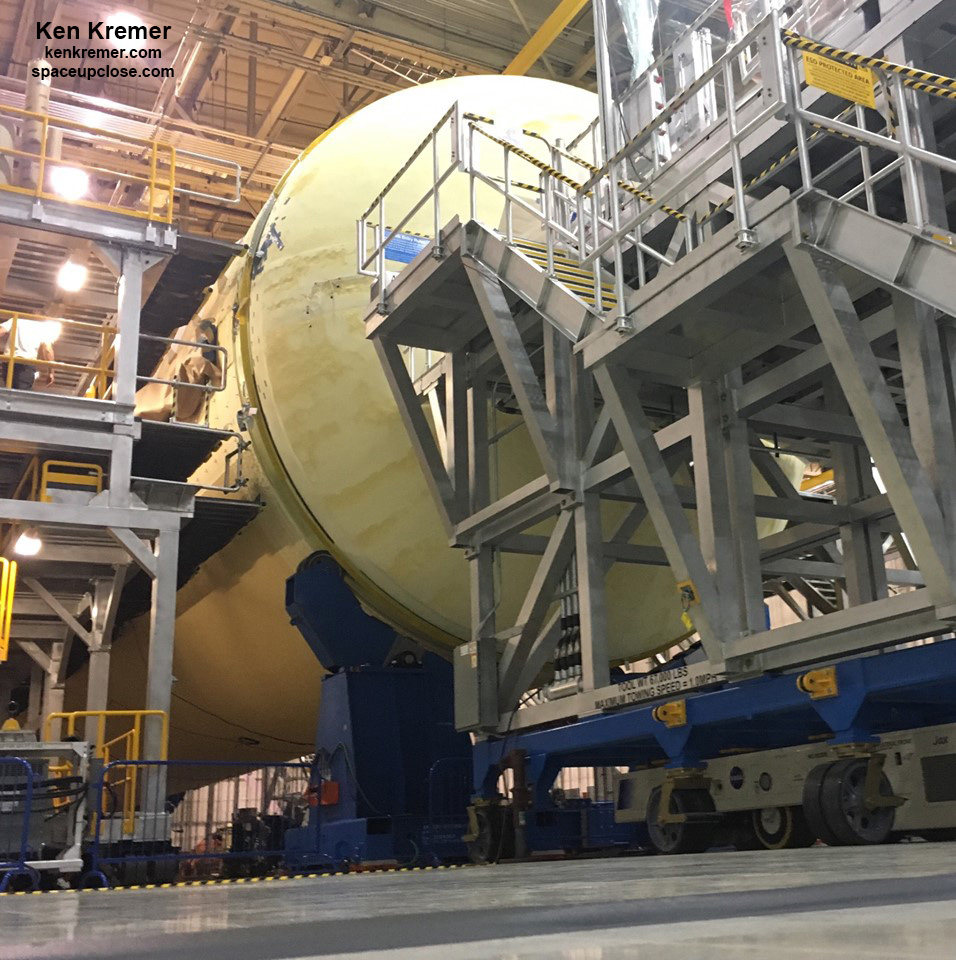 |
|
The core stage for NASA first Space Launch System (SLS) rocket for the Artemis 1
mission is being manufactured at NASA’s Michoud Assembly Facility in New Orleans as seen here on June 28, 2019. The RS-25 engines will be installed into the SLS engine section Summer 2019. Credit: Ken Kremer/kenkremer.com/spaceupclose.com |
Manufacture of SLS Core Stage-1 is about four/fifths complete right now.
The last of the four RS-25 engines that will power the core stage were delivered from NASA’s Stennis Space Center near Bay St. Louis, Mississippi, to Michoud on June 27, 2019 – and I visited them Up Close the next day on Friday, June 28 as part of our media tour. And they were a magnificent sight to behold!
The next step at Michoud will be to complete the assembly of the core stage by finishing construction and outfitting of the bottom engine section and integrating it onto the bottom of core stage 1.
The four RS-25 engines will then be installed by technicians and engineers from NASA and Aerojet-Rocketdyne.
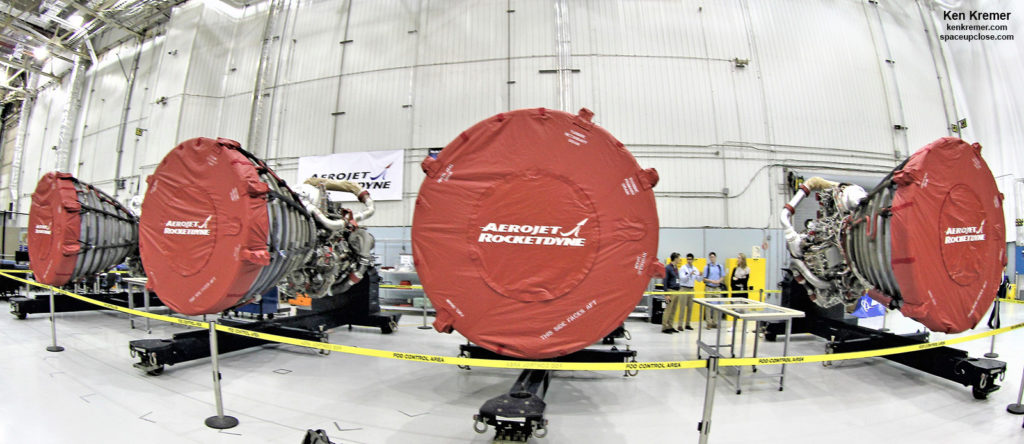 |
|
Crews delivered the last of four RS-25 engines for Artemis 1, the first flight of NASA’s Space Launch System (SLS) rocket and the Orion spacecraft, from NASA’s Stennis Space Center near Bay St. Louis, Mississippi, to NASA’s Michoud Assembly Facility in New Orleans on June 27, 2019. The Aerojet Rocketdyne engines are lined up side-by-side on June 28 and will be installed
into the SLS engine section Summer 2019. Credit: Ken Kremer/kenkremer.com/spaceupclose.com |
The RS-25 engines are recycled from NASA’s space shuttles where clusters of three then called Space Shuttle Main Engines or SSMEs powered the orbiters and propelled 135 missions to space.
NASA now has 16 RS-25 engines in inventory. They have been modified and upgraded to power SLS. They were originally built and then refurbished by Aerojet Rocketdyne.
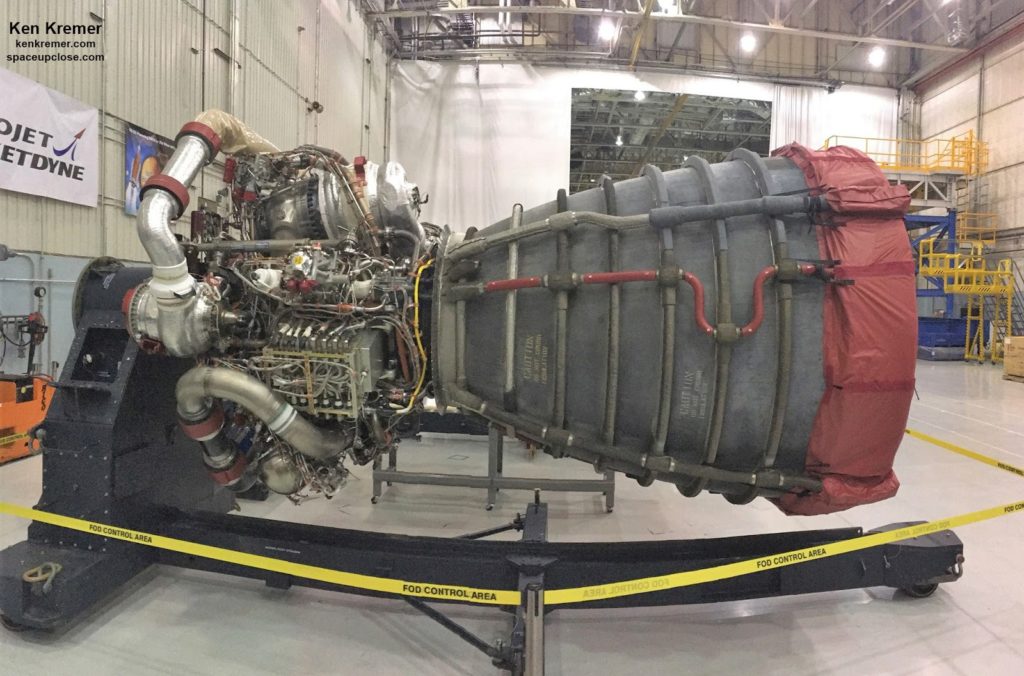 |
|
UpClose view of an RS-25 engine destined for Artemis 1, the first flight of NASA’s Space Launch System (SLS) rocket and the Orion spacecraft after delivery to NASA’s Michoud Assembly Facility in New Orleans. The Aerojet Rocketdyne engine seen on June 28 will be installed into the SLS engine section Summer 2019. Credit: Ken Kremer/kenkremer.com/spaceupclose.com
|
NASA hopes to complete the assembly of Core Stage 1 by December in order to have any chance of achieving a launch before the end of 2020 and the end of President Trump’s current term in office.
But SLS is years behind schedule and billions over budget because of repeated difficulties encountered by prime contractor Boeing in manufacturing Core Stage-1. Thus the launch date for Artemis 1 has slipped 3 years from 2017 and a reliable date is hard to predict.
The Trump Administration agreed to provide NASA with a $1.6 Billion budget boost to the Fiscal Year 2020 budget request for NASA in order to achieve the 2024 south pole landing.
Bridenstine is working hard with Congress to obtain the additional funds which are required to
kickstart development of a new human lunar lander – that’s the missing component.
Artemis 1 will be the first mission launching Orion on the SLS rocket from Kennedy’s Launch Pad 39B. The mission will take Orion thousands of miles past the Moon on an approximately three-week test flight.
Orion will return to Earth and splashdown in the Pacific Ocean off the coast of California, where it will be retrieved and returned to Kennedy.
Assembly of the Orion crew capsule launching on Artemis-1 was declared complete by VP Pence 1 week ago on July 20 – during a speech at KSC honoring the 50th anniversary of mankind’s first Moon Landing on Apollo 11.
When complete, the core stage will measure 212 feet tall (64.6 meters) from tip to tip and 27.6 feet (8.8 meters) in diameter.
It weighs approximately 188,000 lbs (85,275 kg) empty and is constructed from Aluminum 2219.
The core stage is derived from the Space Shuttle External Tank (ET) – all of which were also
built at Michoud for 135 space shuttle launches. The core stage is about 20% longer than the ET.
“Green Run is a historic moment for NASA and Stennis for a number of reasons,” said
Dr. Richard Gilbrech, Director, Stennis Space Center, in a statement.
“For the first time in NASA’s history, a launch vehicle will use flight hardware for its
first test, and the Stennis test stands will once again test the core stage for
Moon missions.”
“Historically, other NASA rockets built to carry astronauts have used main propulsion test articles to test the integrated engines and main propulsion system. The SLS program is performing the stage testing with flight hardware. Once the validation of the stage is complete, the entire stage will be checked out, refurbished as needed, and then shipped to NASA’s Kennedy Space Center in Florida for the Artemis 1 launch. The next time the core stage engines roar to life will be on the launchpad at Kennedy.”
The team at Stennis has spent years refurbishing and renovating the historic B-2
Test Stand specifically to prepare for the “Green Run” test.
B-2 was used in prior NASA human launch programs to test stages for the Saturn V and the space shuttle propulsion system in the 1970s – but not in a fully integrated fashion later used in an actual astronaut launch.
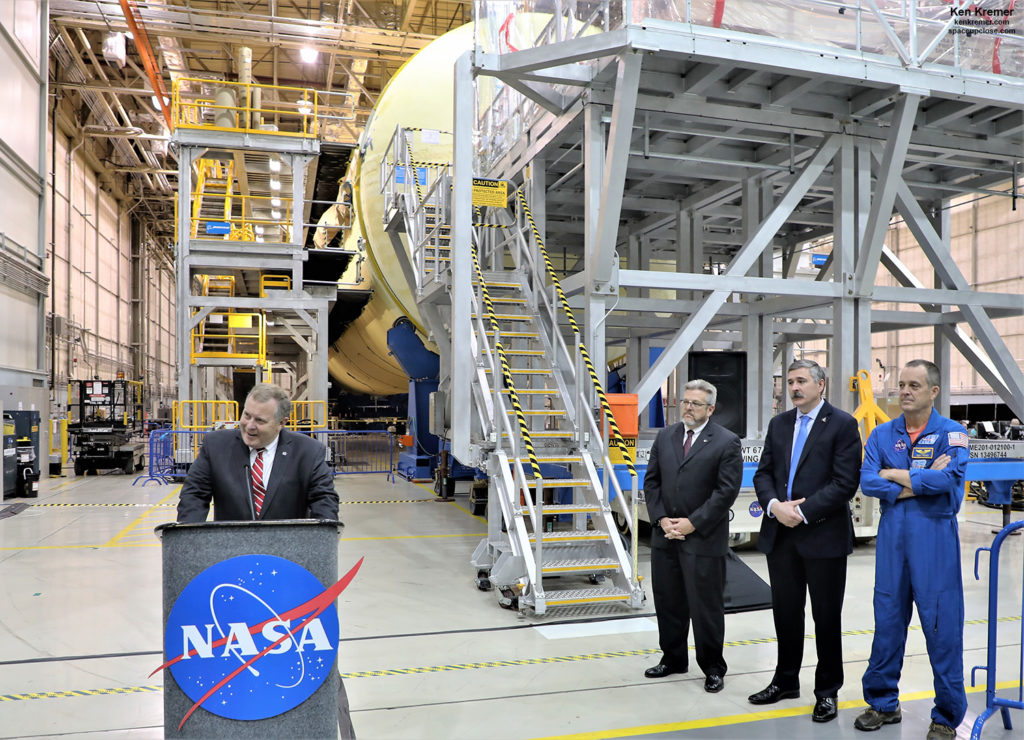 |
|
NASA Deputy Administrator James Morhard speaks
with media in front of flight hardware for Artemis 1 during his first visit to NASA’s Michoud Assembly Facility in New Orleans Friday, June 28, 2019. Michoud is manufacturing the core stage for NASA’s Space Launch System (SLS) rocket. Credit: Ken Kremer/kenkremer.com/spaceupclose.com |
The SLS core stage and test articles are shipped to various NASA centers on NASA’s fortified and lengthened Pegasus barge.
After the ‘green run’ test campaign is successfully completed, Core Stage-1 will travel by boat inside Pegasus from Stennis to KSC.
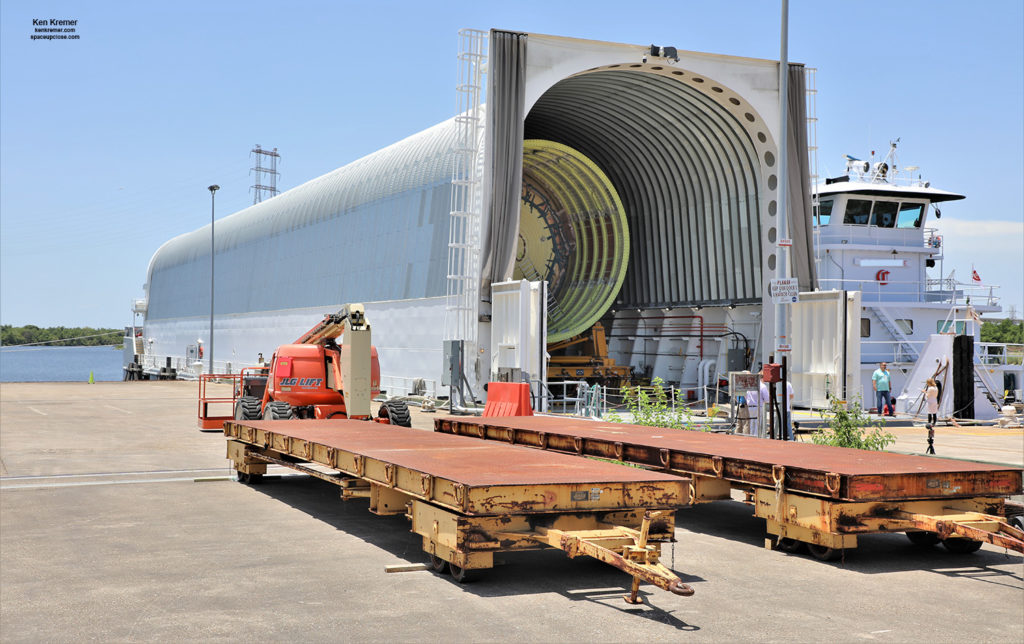 |
|
NASA’s Pegasus barge ready to haul an SLS LOX structural test article on June 28, 2019
from NASA Michoud to NASA Marshall for structural testing. Credit: Ken Kremer/kenkremer.com/spaceupclose.com |
Orion Artemis 1 being manufactured by prime contractor Lockheed Martin at KSC is moving forward and seems likely to be able to support a 2020 launch atop SLS.
In fact earlier this month NASA conducted the critical Ascent Abort-2 (AA-2) test on July 2 and confirmed that the launch abort system tower can successfully pull Orion away in a split second in case of a catastrophic rocket failure.
See our AA-2 articles and photos.
And the ground systems for SLS are also on track at NASA’s Kennedy Space Center in Florida.
The refurbished and enhanced SLS Mobile Launcher was rolled out late June to the top of Launch Complex 39B from which it will launch. See our photos.
Thus the Artemis 1 launch date hinges on completion and certification of SLS Core Stage-1.
Watch for Ken’s continuing onsite coverage of NASA, SpaceX, ULA, Boeing, Lockheed Martin, Northrop Grumman and more space and mission reports direct from the Kennedy Space Center, Cape Canaveral Air Force Station, Florida and Wallops Flight Facility, Virginia.
Stay tuned here for Ken’s continuing Earth and Planetary science and human spaceflight
news: www.kenkremer.com
–www.spaceupclose.com – twitter @ken_kremer – email: ken at kenkremer.com
Dr. Kremer is a research
scientist and journalist based in the KSC area, active in outreach and interviewed
regularly on TV and radio about space topics.
………….
Ken’s photos are for sale and he is available for lectures and outreach events



